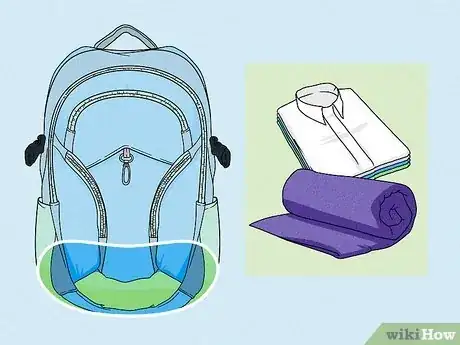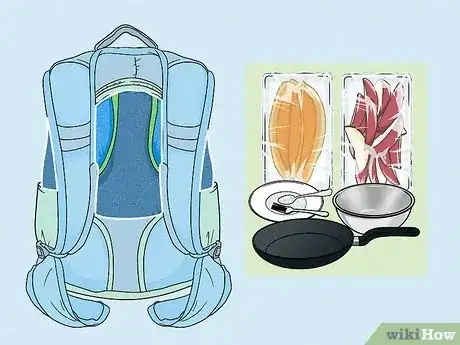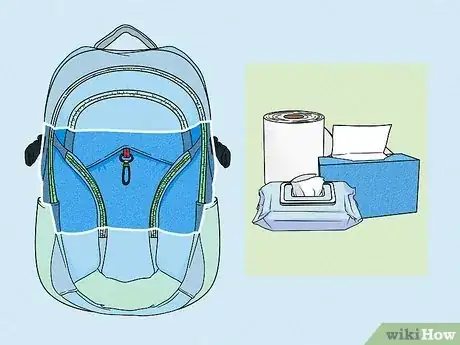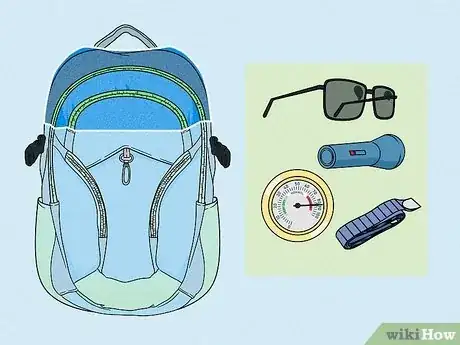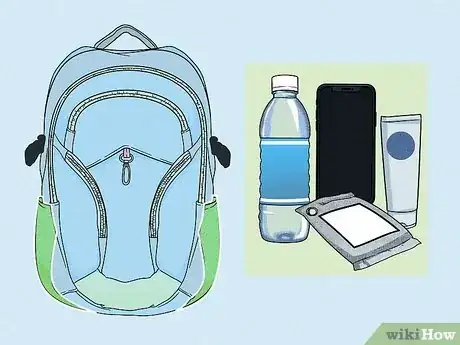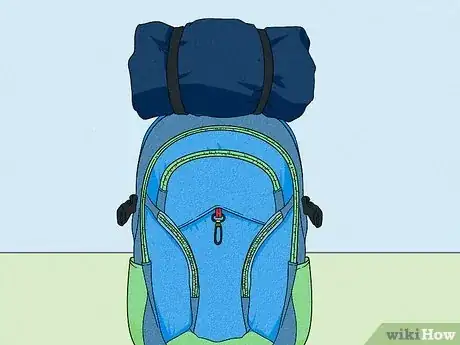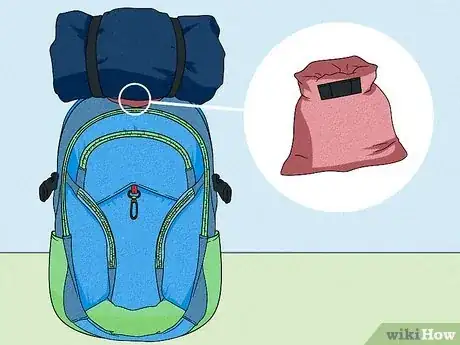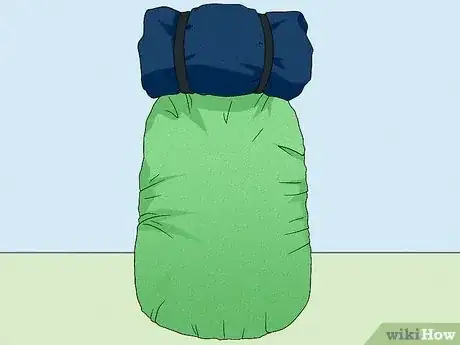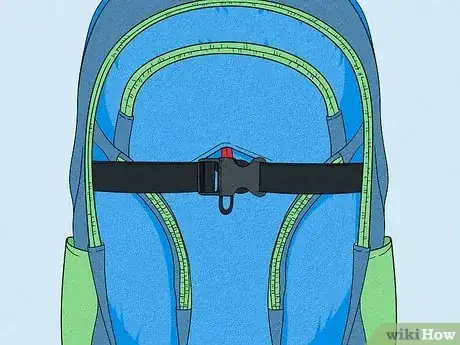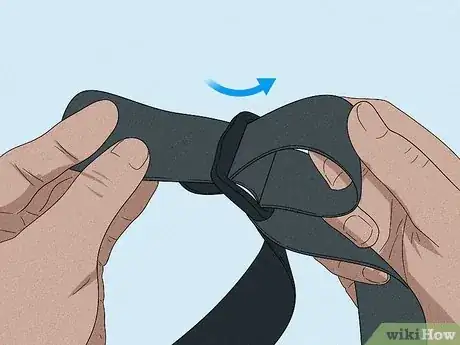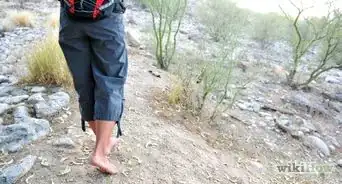This article was co-authored by Thomas Churchill and by wikiHow staff writer, Dan Hickey. Thomas Churchill has been leading hiking and backpacking trips across California for the last five years as a Stanford Pre-Orientation Trip Leader and Adventure Program Guide. Most recently, Thomas was a Hiking Leader for 3 months at Stanford Sierra Conference Center, leading day hikes in the Desolation Wilderness of Northern California.
There are 9 references cited in this article, which can be found at the bottom of the page.
wikiHow marks an article as reader-approved once it receives enough positive feedback. In this case, several readers have written to tell us that this article was helpful to them, earning it our reader-approved status.
This article has been viewed 136,541 times.
The weather is perfect for a hike and you can’t wait to toss everything into your backpack and hit the trail. Take your time when you pack, though—the way you distribute the weight of your items can make or break your comfort (or your back!). That’s why we’ve put together a handy guide to packing a hiking backpack so you can make the most of your pack’s space and stay balanced. Keep scrolling, grab that trail mix, and have a great hike!
Steps
Packing Your Backpack’s Compartments
-
1Bottom Zone: store infrequently used and bulky items in this section. These items at the bottom give you a foundation to stack your other belongings on top of and ensure the bottom of the pack isn’t too heavy. These will be the hardest to reach on the trail, so use this space for anything you won’t need until you stop to make camp.[1]
- This zone will almost always include your sleeping bag, as well as things like sleeping mats and spare clothes or towels.
- Some backpacks have a separate sleeping bag compartment.
- If you have an external frame backpack, lash your sleeping bag to the frame underneath the actual pack.
-
2Back Middle Zone: place your heaviest items here. Putting heavy items in the middle of your back creates a stable center of gravity that’s comfortable over long periods. These should be things you won’t need until you make camp. To save space, fill any cookware or containers with other items, like food or clothing.[2]Advertisement
-
3Front Middle Zone: store light, infrequently needed items in this section. This is the section of the main backpack compartment that’s farthest from your body, so always keep it light for balance and comfort. If an item is very light but you know you’ll need it frequently, save it for the top portion of your backpack or an exterior pocket or pouch.[3]
- Items in this section might include a spare jacket or sweatshirt, a first aid kit, flashlights, and toiletries.
-
4Top Zone: put your light, frequently used trail essentials here. These items will be the easiest to access, so save this space for things you know you’ll use on the trail. This way, you don’t have to stop and unpack everything to grab a snack! Try not to overpack this top portion—too much weight makes you more likely to fall over if you lose your balance.[4]
- Put things like snacks, a compass, sunscreen, sunglasses, a rain jacket or poncho, an umbrella, or a water filter in this top portion.
-
5Outside Pockets: store small, easily misplaced essentials in these. Use the side and hip belt pockets to easily stash any tiny item you’ll need to grab often since small objects can get lost in big backpacks. Most hiking backpacks also have a stretchy front pouch (called a kangaroo pouch) that’s great for lightweight must-haves too big for smaller pouches.[5]
- Store water bottles in your side pockets and small things like lip balm, maps, more snacks (hiking takes energy!), a pocket knife, or your phone in your hip belt.
- Kangaroo pouches are great for organizing similar lightweight items together, like hand sanitizer and bathroom kits or light jackets, small blankets, and bandanas.
-
6Loops and Lash-On Points: attach large gear that doesn’t fit inside here. Try to evenly distribute the weight of big exterior items for balance and comfort. These items can be unwieldy and snag on branches or rocks, so try to lash on as few items as possible.[6]
- Lash on things like trekking poles, tent poles, climbing rope, an ice axe, or even a camping chair to the exterior of your pack.
- To save space, some hikers lash their sleeping bag outside their backpack too.
-
7Fill in packing gaps with soft items like clothes. For each layer of your backpack (bottom, middle, top), pack your hard items with firm shapes first. Then, use malleable items like spare clothes, a rain jacket, or a blanket to fill in the space between the hard items.[7]
- This method makes the most of the space in your backpack and also stabilizes the hard, heavy items so they don’t move around while you hike.
- Use stuff sacks (drawstring bags for camping and hiking) to keep like items together or to compress soft items like clothes and blankets.
-
8Protect your pack from rain with a waterproof rain cover. The most common covers go around the outside of your backpack and fasten around the back panel with a cord (some backpacks come with one). Pack a cover and take time to put it on if there’s wet weather in the forecast.[8]
- A wet backpack is heavy, even if the contents inside are dry.
- Protect your clothing, electronics, and bedding by putting them in plastic bags inside your backpack (even if you have a rain cover).
- If you don’t have a cover, line the inside of your backpack with a trash compactor bag before you begin packing. They’re cheap, light, and good at keeping your belongings dry.
Hoisting and Adjusting a Loaded Backpack
-
1Tighten the compression straps once you’re fully packed. As you tighten them, any unused pockets of space in your pack will shrink and the weight of your items will shift closer to your back. Pull them until they’re quite snug—this will keep items from moving around and shifting the weight distribution while you hike.[9]
- If your load is light compared to the volume of your pack, lay the pack on its back panel and evenly distribute your items before you tighten the compression straps.
- Keep the compression straps loose while you pack to make the best use of your space.
-
2Loosen the shoulder straps and hip belt before you lift your backpack. This will make it easier to slip on later.[10] Tilt the backpack upright and then position yourself next to the back panel with your legs shoulder-width apart and your knees slightly bent.
-
3Lift the backpack up to your thigh with the haul loop. The haul loop is at the top of the back panel of your backpack. Let it rest on your thigh for a moment so you can feel the weight of it, keeping your hand on the haul loop for balance.[11]
-
4Slide the backpack onto your shoulders. First, slide the arm that’s on the same side as the backpack into a shoulder strap. Lean forward to shift the backpack onto your back and then slide your other arm into the other shoulder strap.[12]
-
5Buckle everything up and adjust the straps to fit comfortably. Tighten the hip belt first, making sure it’s resting on your hips and not above them. Adjust the shoulder straps and load lifters next, and adjust the load stabilizers on the hip belt last. Make sure the sternum strap is supportive, but not so tight that you can’t breathe freely.[13]
- Most of the weight should rest on your hips. The shoulder straps are designed to keep the weight closer to your back, not to hold it up.[14]
-
6Remove unnecessary items if your backpack is too heavy. The number one indicator your backpack is too heavy is your comfort—if you’re in pain, exhausted, or distracted by the weight, unpack any non-essential items and redistribute the weight so the heaviest items are close to your back.[15] Other signs your pack is too heavy are:
- You have to sit down to put it on.
- The top of the bag is above your head when fully loaded.
- You’re leaning too far forward while you hike.
- You have to rummage through your backpack to find things because you can’t remember where you put them.
- After your last trip, you realized you packed things that never ended up getting used (besides essentials like a first aid kit).
Community Q&A
-
QuestionWhat would I need to hike a trail by a river?
 Community AnswerDefinitely a lot of water, hiking shoes, windproof jackets, bug repellent, a change of clothes, and a waterproof bag preferably. This varies depending on the time of year.
Community AnswerDefinitely a lot of water, hiking shoes, windproof jackets, bug repellent, a change of clothes, and a waterproof bag preferably. This varies depending on the time of year. -
QuestionHow do I pack if I'm 10 and I'm hiking in the woods near my house?
 Community AnswerFirst, you should see if you have a parent, family member, or friend to go with you just in case, because a lot can go wrong. Packing depends on weather conditions and the climate, but you might want to bring a map or compass, sunscreen, insulation (extra clothes), a flashlight, a small first aid kit, extra (nutritious!) food and water. Also, make sure you wear proper shoes for hiking.
Community AnswerFirst, you should see if you have a parent, family member, or friend to go with you just in case, because a lot can go wrong. Packing depends on weather conditions and the climate, but you might want to bring a map or compass, sunscreen, insulation (extra clothes), a flashlight, a small first aid kit, extra (nutritious!) food and water. Also, make sure you wear proper shoes for hiking. -
QuestionWhat is the final weight of the bag?
 Community AnswerIt depends entirely on what you put into your hiking backpack, but you don't want one that's so heavy you won't be able to carry it.
Community AnswerIt depends entirely on what you put into your hiking backpack, but you don't want one that's so heavy you won't be able to carry it.
References
- ↑ https://americanhiking.org/resources/how-to-pack-a-backpack/
- ↑ https://coolofthewild.com/how-to-pack-a-backpack/
- ↑ https://coolofthewild.com/how-to-pack-a-backpack/
- ↑ https://coolofthewild.com/how-to-pack-a-backpack/
- ↑ https://americanhiking.org/resources/how-to-pack-a-backpack/
- ↑ https://coolofthewild.com/how-to-pack-a-backpack/
- ↑ https://www.travelchannel.com/interests/outdoors-and-adventure/articles/10-tips-for-packing-a-backpack
- ↑ https://americanhiking.org/resources/how-to-pack-a-backpack/
- ↑ https://www.artofmanliness.com/skills/outdoor-survival/how-to-pack-backpacking/
- ↑ https://americanhiking.org/resources/how-to-pack-a-backpack/
- ↑ https://youtu.be/eVOFq5Pdw_w?t=63
- ↑ hhttps://youtu.be/eVOFq5Pdw_w?t=76
- ↑ https://thebackpackguide.com/how-to-put-your-backpack-on-properly
- ↑ https://scoutlife.org/video-audio/136868/how-to-pack-a-backpack/
- ↑ https://www.thehikinglife.com/2019/03/14-signs-you-are-carrying-too-much-stuff-in-your-backpack/
- ↑ https://americanhiking.org/resources/how-to-pack-a-backpack/
- ↑ https://americanhiking.org/resources/how-to-pack-a-backpack/
About This Article
To pack a hiking backpack, load your lightest gear, like your clothing and sleeping bag, at the bottom of your pack. Then, place your heaviest items, like your water and cooking utensils, between your shoulder blades so the weight doesn't injure your back. Next, place medium-weighted objects, like food and flashlights, all around the edges of the pack. Finally, place essential items, like bug spray, maps, and snacks, in easily accessible pouches. To learn how to attach external items to your backpack, keep reading!
